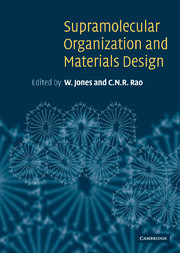Book contents
- Frontmatter
- Contents
- List of contributors
- Preface
- 1 Assembly and mineralization processes in biomineralization: strategies for forming biological composite materials
- 2 Mesoscale materials synthesis and beyond
- 3 Towards the rational design of zeolite frameworks
- 4 Mesoscale self-assembly: the assembly of micron-and millimeter-sized objects using capillary forces
- 5 Design of amphiphiles for the modulation of catalytic, membranous and gelation properties
- 6 Nanofabrication by the surface sol-gel process and molecular imprinting
- 7 The hierarchy of open-framework structures in metal phosphates and oxalates
- 8 Mesoscale self-assembly of metal nanocrystals into ordered arrays and giant clusters
- 9 Layered double hydroxides as templates for the formation of supramolecular structures
- 10 Molecular machines
- 11 Some aspects of supramolecular design of organic materials
- 12 Controlling crystal architecure in molecular solids: the supramolecular approach
- Index
1 - Assembly and mineralization processes in biomineralization: strategies for forming biological composite materials
Published online by Cambridge University Press: 18 December 2009
- Frontmatter
- Contents
- List of contributors
- Preface
- 1 Assembly and mineralization processes in biomineralization: strategies for forming biological composite materials
- 2 Mesoscale materials synthesis and beyond
- 3 Towards the rational design of zeolite frameworks
- 4 Mesoscale self-assembly: the assembly of micron-and millimeter-sized objects using capillary forces
- 5 Design of amphiphiles for the modulation of catalytic, membranous and gelation properties
- 6 Nanofabrication by the surface sol-gel process and molecular imprinting
- 7 The hierarchy of open-framework structures in metal phosphates and oxalates
- 8 Mesoscale self-assembly of metal nanocrystals into ordered arrays and giant clusters
- 9 Layered double hydroxides as templates for the formation of supramolecular structures
- 10 Molecular machines
- 11 Some aspects of supramolecular design of organic materials
- 12 Controlling crystal architecure in molecular solids: the supramolecular approach
- Index
Summary
Introduction
Many organisms produce materials with mechanical properties that are better than those of comparable synthetically produced materials, built from the same or similar basic components [1, 2]. The key to biological material production is, of course, the genetically programmed activities of cells, that reflect the accumulated experience of evolving by trial and error field testing over tens, if not hundreds, of millions of years. It is highly unlikely that the synthetic processes that humans are capable of performing will ever be able to reproduce or even mimic these cellular functions. Detailed studies of the structure of the formed material and the formation processes involved in producing the material can, however, provide an understanding of the basic design and assembly principles incorporated into the structure. Materials scientists may then be able to use some of this knowledge to improve the fabrication processes and the performance of novel synthetic materials.
The key components in all sophisticated biological materials are the macromolecules that the cells produce and subsequently incorporate into the material. These include proteins, glycoproteins, proteoglycans, lipid assemblies and polysaccharides. Many biological materials are composed almost entirely of these assembled macromolecules. Common examples are the cuticles of many insects, the skin and tendons of vertebrates or the silk of spider webs. A very widespread adaptation is to stiffen the material by the introduction of a mineral phase. Common mineralized biological materials include the shells of mollusks, the carapaces of crustaceans, and the bones and teeth of vertebrates.
- Type
- Chapter
- Information
- Supramolecular Organization and Materials Design , pp. 1 - 33Publisher: Cambridge University PressPrint publication year: 2001

